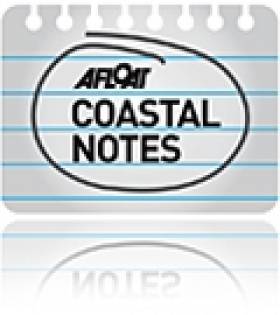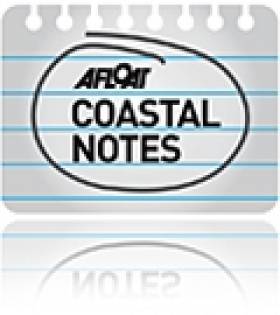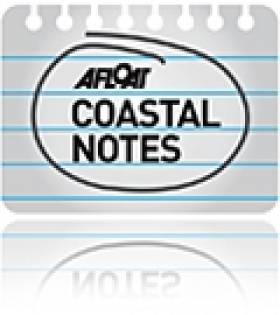Displaying items by tag: Coastal Notes
Locals Boast About Ireland's Coast From Belfast To West Cork
#CoastalNotes - Professional snowboarder Aimee Fuller tells the Guardian about her favourite attractions around the coast of Northern Ireland.
From the new Titanic Belfast centre to the city's renowned St George's Market, the spectacular views of Belfast Lough from the top of Cave Hill, peaceful lough-side walks in Holywood and surfing in Portrush, the English pro - who moved to NI in her teens - shows there's a lot to love about her adopted home.
Meanwhile, at the opposite end of the island of Ireland, West Cork is hailed as "a perfect place to sea-kayak, relax and drink in nature", according to the Wall Street Journal - whose writer Javier Espinoza paddles out on a coastal tour with Atlantic Sea Kayaking.
Though the area is tinged with tragedy - after last year's loss of five fishermen with the sinking of the Tit Bonhomme - there is respect and admiration for the sea, especially on a calm day when kayakers can glide from shipwrecks to forests to bird sanctuaries in a single excursion.
Pipeline Tunnel Costs Weigh On Corrib Gas Partners
#Corrib - Partners in the Corrib Gas Project in the West of Ireland face a bill of nearly €3.4 billion before the end of 2014 - due in part to the pipeline plans falling foul of An Bord Pleanála, as The Irish Times reports.
Some €380 million will be spent next year - and an estimated €300 million more in 2014 - on completing the construction of a 5km tunnel mandated by Ireland's planning authority over safety concerns regarding half of the project's proposed overground pipeline.
Originally set to flow in 2003, the controversial gas field project will be at least 12 years behind schedule when production is ready to begin.
The Irish Times has more on the story HERE.
Gathering of This Island Nation Explores Our Maritime Heritage
#MaritimeHeritage - The National Maritime Museum of Ireland (NMMI) in Dun Laoghaire recently hosted a two-day Maritime Heritage Gathering funded by the Department of Arts, Heritage and the Gaeltacht and supported by Dun Laoghaire Rathdown County Council and Gathering Ireland 2013.
Welcoming more than 100 participants from among 60 organisations from the island of Ireland and the UK was An Cathaoirleach Carrie Smyth of Dun Laoghaire-Rathdown County Council.
The diversity of participants ranged from maritime museum managers, historians, authors, genealogists, deep-sea divers, archaeologists, shore built heritage and inland waterways enthusiasts, former dockers, historic boat restorers, community development groups and Government agencies.
The maritime gathering recognised the need to share the common objective of raising the profile of a collective maritime heritage and highlight its tourism potential. It is the determination of locally funded museums, historical societies and individuals to preserve the historic, cultural and folklore memory of Ireland's 3,500 mile coastline, despite current economic circumstances, with the assistance of State agencies was emphasized.
The importance of making all things maritime more accessible to school children linking museums with local heritage groups, sailing clubs and utilising the internet and 3-D visual technology to develop virtual museums featured amongst a host of ideas from six expert groups.
Participants agreed to co-operate to develop national and trans-national projects through a common Maritime Heritage Platform sharing resources and supporting one another. Workshop discussion groups provided opportunities to exchange ideas under the following core topic headings:
• Future Development of Maritime Museums in Ireland
• Preservation of Historic Ships and Traditional Boats
• Developing the Research Capabilities of Irish Maritime Libraries and Archives
• Maritime Tourism Initiatives, Marketing and Communications
• Co-operation in Maritime Heritage Networks, Joint Projects and Special Exhibitions
Mr Jim Deenihan TD, Minister for Arts, Heritage and the Gaeltacht, said that historically Ireland had ignored its maritime heritage, but this is rapidly changing and the rising interest in genealogy actively promoted by his department through www.irishgenealogy.ie has created a new window of opportunity for positive developments in the maritime field.
The Minister was particularly impressed with the pro-active approach of the National Maritime Museum (home of the Maritime Institute of Ireland) in preserving its historic artefacts and unique 4,000 volume maritime library and archive. The fact that so many representatives came together for the very first time to find workable solutions to promote maritime heritage indicated a very strong statement of intent from the maritime heritage sector, which his department recognises.
Last year the National Maritime Museum was officially reopened by the museum's patron President Michael D. Higgins. The former Mariners Church where the museum is located has a primary objective in the promotion and development of a greater awareness of Irish maritime heritage, our historical seafaring figures and the role of shipping.
For six years the Mariners Church underwent an extensive structural renovation programme financed by Government grant aid. The renovation of the building has ensured that its distinctive architectural features and valuable artefacts and library are preserved for generations to come.
Maritime events, lectures, guided tours for schools, adult societies and special interest groups occur regularly. The venue also hosts civic, cultural and corporate events all year round. For further information visit: www.mariner.ie
Rosslare Harbour Maritime Heritage Centre Celebrates 1st Anniversary
#MaritimeHeritage - The Rosslare Harbour Maritime Heritage Centre recently celebrated a first year anniversary, writes Jehan Ashmore.
The centre housed in the former Tourist Office close to the ferryport displays the maritime heritage of the area and which has been given valued support by the local community and beyond.
Open every Saturday, Sunday and Bank Holidays between14.00 –l8.00hrs. Admission for Adults is €3.00 and Children are FREE.
The centre is happy to accommodate visitors outside normal opening hours provided they are given sufficient notice.To contact email: [email protected] and by following updates and events on their facebook page.
Currently the centre which is run by the Rosslare Maritime Shipping Enthusiasts are holding a photographic exhibition featuring Irish Shipping Ltd. The exhibition has also been extended to the John Barry Pub in Wexford Town where a fine collection of paintings by maritime artist Brian Cleare can be viewed and purchased in the upstairs gallery.
Brian Cleare and his colleagues of the Rosslare Maritime Enthusiasts as previously reported on Afloat.ie are to launch later this month the publication Irish Shipping Ltd – A Fleet History
The publication is lavishly illustrated with more than 400 photographs detailing the many ISL vessels. The book is eagerly awaited not just by seafarers who served the state-owned shipping company that collapsed in 1984 but to many followers at home and overseas with a keen interest in Irish merchant shipping history.
‘Afloat’ Project Launches Vessels with Messages of Positivity
#AfloatProject – As previously reported, the 'Afloat' project of Dalkey-based visual artist, Roisin Cunningham, took place on Sunday where 50 bottle jars containing messages about the recession made contact in the waters of Dublin Bay, writes Jehan Ashmore.
Since then the first jar (No.22) has been found washed ashore this morning by a woman while walking on the beach at Sutton. The jar had drifted from the location of the bottle launch in the seas off The Muglins near Dalkey Island in the south of the bay. For a photo, click the link to Roisin's 'Afloat' facebook page.
The inspiration for the Afloat project had originated several years ago and is based on the main theme of communication between people and how this can be achieved. What appealed to the artist is the idea of using ordinary people's messages, often because their ideas have no platform.
As the ideas gathered, she was surprised and encouraged at how when asked to send a personal message to a stranger, people engaged in such a positive way with inspirational quotes or greetings.
The messages in the jars not only reflected the state of the nation in which in recent years we seemed to have, as an Island people, had many ideas and criteria forced on us. This is where Roisin wanted to gauge what was the general mood among the people.
In addition the jars contained a paper boat and a numbered piece taken from a painting of the Muglins painted by the artist.
The rocky outcrop of The Muglins and its lighthouse is where strong currents converge and which can make for notoriously unpredictable conditions.
Despite the swells at high-tide and under an overcast sky, Roisin was rowed out from Coliemore Harbour by the Dalkey Rowing Club's Ladies junior team, crewed by Nadine Cunningham, Sinead McCullogh, Claire Cunningham and Mary-Grace Power. They clearly displayed their rowing skills coupled by the cox of the day Pat Dalton.
So where have the natural elements taken the other jars as they bob and drift about the Irish Sea and who knows to where else?...
#SHACKLETONcalling – In celebration of the greatest survival story of all time!.. All Shackletons, Creans, McCarthys and descendants of the 28-strong crew of the legendary Endurance expedition (1914-16) will congregate for a momentous Gathering at Dún Laoghaire's Shackleton Exhibition this Friday 11 October.
It was 99 years ago that saw three renowned Irish Explorers - Sir Ernest Shackleton, Tom Crean and Tim McCarthy - embark on what would become the most legendary Antarctica voyage ever – the Endurance expedition.
Five months later disaster struck when the ship was beset by ice leaving the 28 men stranded in 24-hour darkness in the middle of the freezing ocean surviving on seals and penguins for months on end. And then their ship was engulfed by the ocean...
Attendees at this October's Gathering event will relive this remarkable story of survival and persistence told through the actual photographs and video clips taken on the expedition.
Everyone with an interest in the Endurance story is welcome to attend and meet the Hon. Alexandra Shackleton (Sir Ernest Shackleton's granddaughter), four generations of Creans (including Tom Crean's Great-Great Grandson, 13 year old Ben O'Brien) and many more descendants of these remarkable men.
The exhibition, which opened at Dún Laoghaire Ferry Terminal last year, features over 150 real photographs and videos recorded by the expedition photographer, Frank Hurley including the video of the Endurance disintegrating and sinking.
Each picture brings a different part of the story to life: the treacherous open boat journey to Elephant Island, the endless trek across the ice, the impossible 800-mile rescue mission across the South Atlantic Ocean.
The expedition goes down in history as one of the most significant maritime rescue feats of all time. After more than twenty-four gruelling months, the skill, the bravery, the extraordinary persistence of these men and their heroic Irish leader, brought every crew member from the Endurance Expedition home safe and sound.
The Gathering event is to take place this Friday at the Shackleton Exhibition at the front of the Ferry Terminal in Dún Laoghaire and is timed for 11am to 12.30pm.
All Shackletons, Creans McCarthys and other descendants of the Endurance crew are welcome free of charge.
Admission to the exhibition for other attendees is €5 per person.
A special lunch with talks on the Endurance Expedition will take place at the Royal St. George Yacht Club from 1pm to 5pm, cost €20. A limited number of places are still available so please book early.
The Shackleton Exhibition is open all year round. Further information: www.shackletonexhibition.com
Providence Aim to Kickstart Dalkey Island ‘Prospect’ Drilling Plans
#DalkeyOilProspect - Ireland's biggest oil exploration company, Providence Resources is preparing to start work on its Dalkey Island oil drilling once a regulatory 'Snafu' is resolved.
According to Independent.ie (which has more on this story) the Department of the Environment is preparing to amend legislation that will enable Providence Resources to reactivate its foreshore licence, which clears the way for drilling.
Providence handed back its foreshore licence following a legal snarl up over the wording of the permit.
The department had been expected to fix the regulatory issue in May but the timetable has slid.
Latest indications suggest that the new wording will be in place before the end of this year. In its exploration timetable given to investors, Providence has said that it is scheduled to start drilling in the first half of 2015.
Coastwatch Survey 2013: Your Coastline Still Needs You!
#CoastWatchSurvey – Coastwatch Survey 2013 which started last month continues for another fortnight, so there's no excuse not to take part in the annual survey which ends on 15 October.
All you have to do is walk just once along your chosen coastline (500m) around low-tide and report your findings. Participants will help to create more than 1,000 coastal site surveys as a collective citizen snapshot of Ireland's coastline in 2013.
So what's stopping you!... it's useful, fun, challenging and keeps you fit
Note, it is important to inform others before setting off (even if going as a group), of your intended coastal survey route and make sure to bring along a mobile.
If you would like to host one in your area please contact the Coastwatch coordination team.
To review the full survey questionnaire, or to book your survey area (plus download the info-poster and pass on to a friend) For details you can also contact Karin Dubsky, International Coordinator, Coastwatch Europe by contacting: 086 8111 684 or www.coastwatch.org
Coastwatch Europe is an international network of environmental groups, universities and other educational institutions, who in turn work with local groups and individuals around the coast of Europe.
‘Afloat’ Awaits Time & Tides to Launch Bottles of Messages & More!
#AfloatProject – As previously reported, the 'Afloat' project headed by Dalkey based visual artist, Roisin Cunningham who was to launch bottles off The Muglins in Dublin Bay last weekend was cancelled at short notice, writes Jehan Ashmore.
Not deterred, Roisin is to re-schedule the launch date for either day of the weekend 5-6 October. Supporting the launch will come from the Dalkey Rowing Club's Junior Ladies team, who are to row out the East coast club's 'skiff' from Coliemore Harbour to The Muglins off Dalkey Island. From there all 50 bottles will be launched into the Irish Sea.
The overriding theme of 'Afloat' is to reflect on the state of the nation since the financial collapse and asks individuals to probe into how they feel themselves. In addition, the need to question our identity on several levels, as well as a collective expression of society.
Locals and visitors alike were invited over the summer to contribute ideas, quotes, or messages and place them in the bottles which will also include a piece of artwork and a paper boat.
Weather permitting, the location of the small rocky outcrop of The Muglins with its lighthouse was chosen for the bottle launch because of the strong currents that converge in this southern area of Dublin Bay.
A Nation Adrift Awaits ‘Afloat’ Launching of Ideas, Quotes & Messages
#AfloatProject – Dalkey based visual artist Roisin Cunningham is to launch her 'Afloat' project this weekend off The Muglins that neighbours Dalkey Island in south Dublin Bay, writes Jehan Ashmore.
Weather permitting, the location of the small rocky outcrop with its lighthouse was chosen for launching 50 bottles because of the strong currents meeting in this area of the bay.
Locals and visitors alike were invited over the summer to contribute ideas, quotes, or messages and place them in the bottles which will also include a piece of artwork and a paper boat.
The overriding theme of 'Afloat' was to reflect on the state of the nation since the financial collapse and asks individuals to probe into how they feel themselves. In addition, the need to question our identity on several levels, as well as a collective expression of society.
Roisin who is artist in residence at Dalkey Rowing Club, said of the project "is about the proliferation of ideas that can move without being guided or controlled".
It is a search for a truth, as opposed to, the truth and Roisin sees that art has a central task in connecting to human relations and its conditions.
Our culture can dis-joint and can dis-connect us from our lives and we can feel individual and alone. In essence we tend to forget we are a collective and we share many of the same feelings and desires.
The artist had put up quotes and ideas from philosophers, theorists and even Groucho Marx and the central idea is not just about art and artists.
It is about humans and how we live or how should we live and with the purpose of the 'Afloat' project is also to inspire positivity and room for fun!
Now that the project has gathered a diverse amount of messages from Facebook interactions and from people the artist has encountered directly, the time has come to launch them out to sea.
Supporting Roisin in the launch comes from the Dalkey Rowing Club, where the East Coast club's rowing skiff's Junior Ladies team, are to row out the boat from Coliemore Harbour to The Muglins.
From there the vessels on board will be launched overboard. All these bottles bobbing about the water face an unchartered course and equally an unknown outcome awaits... like life itself!






































































